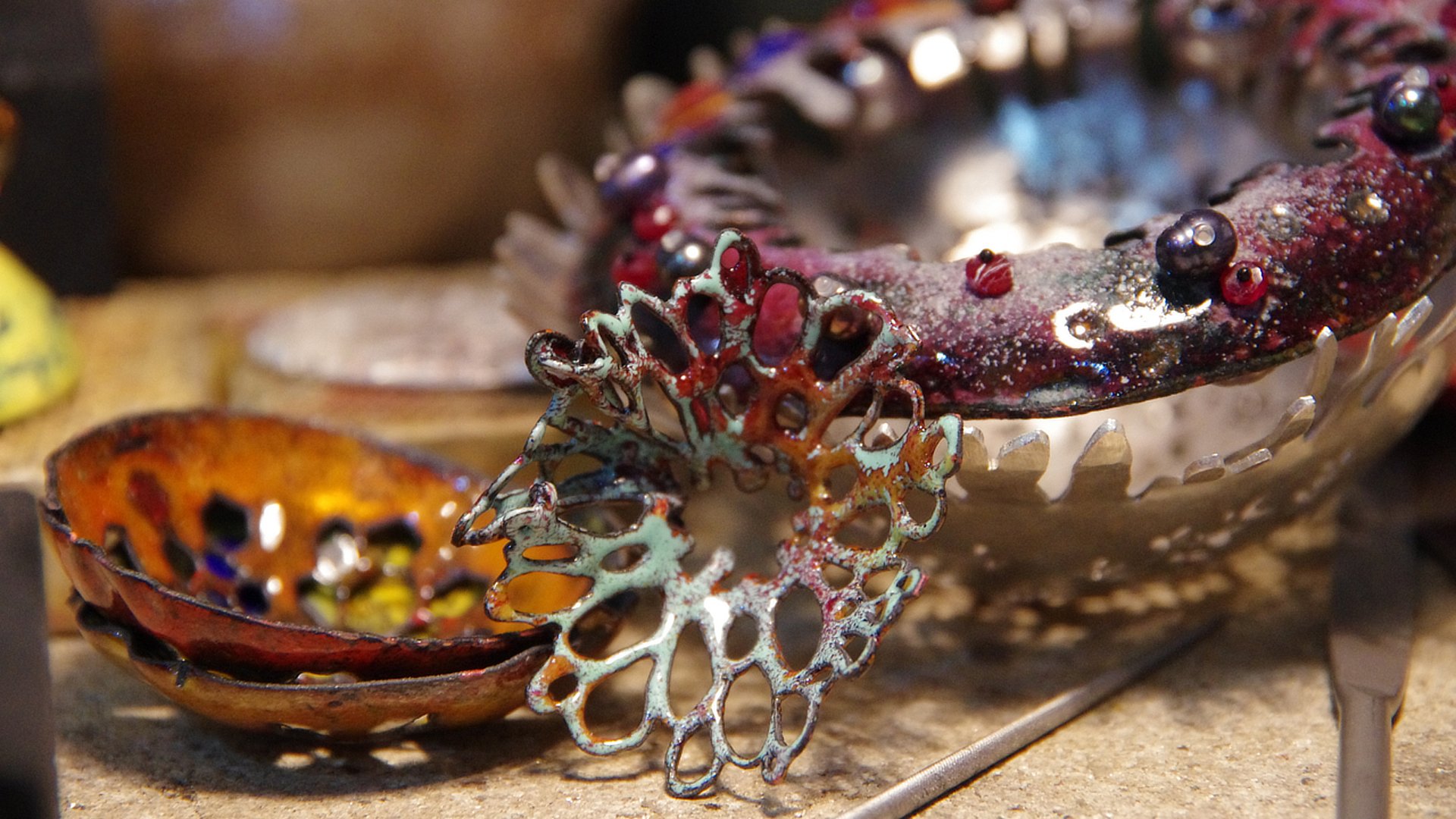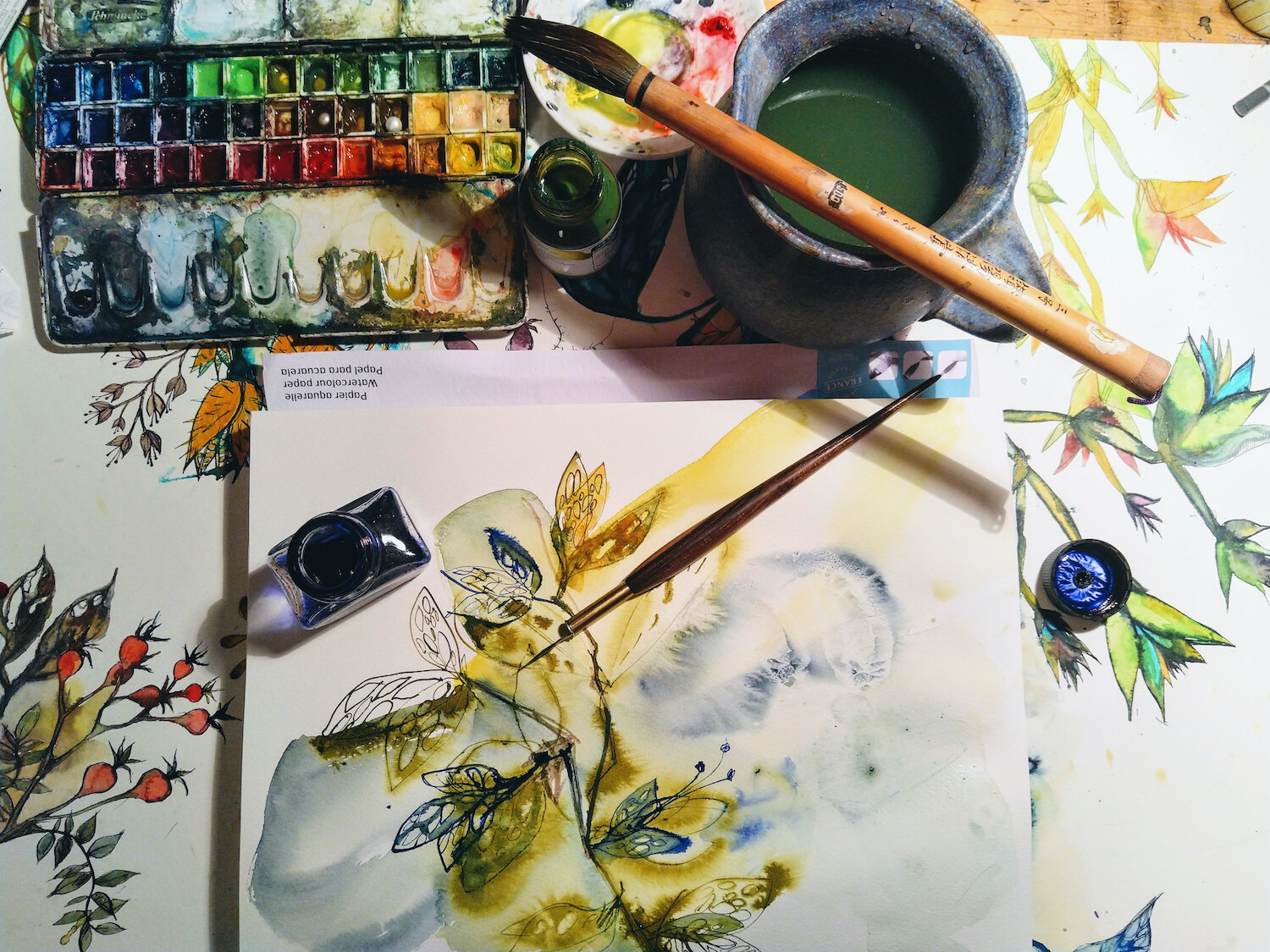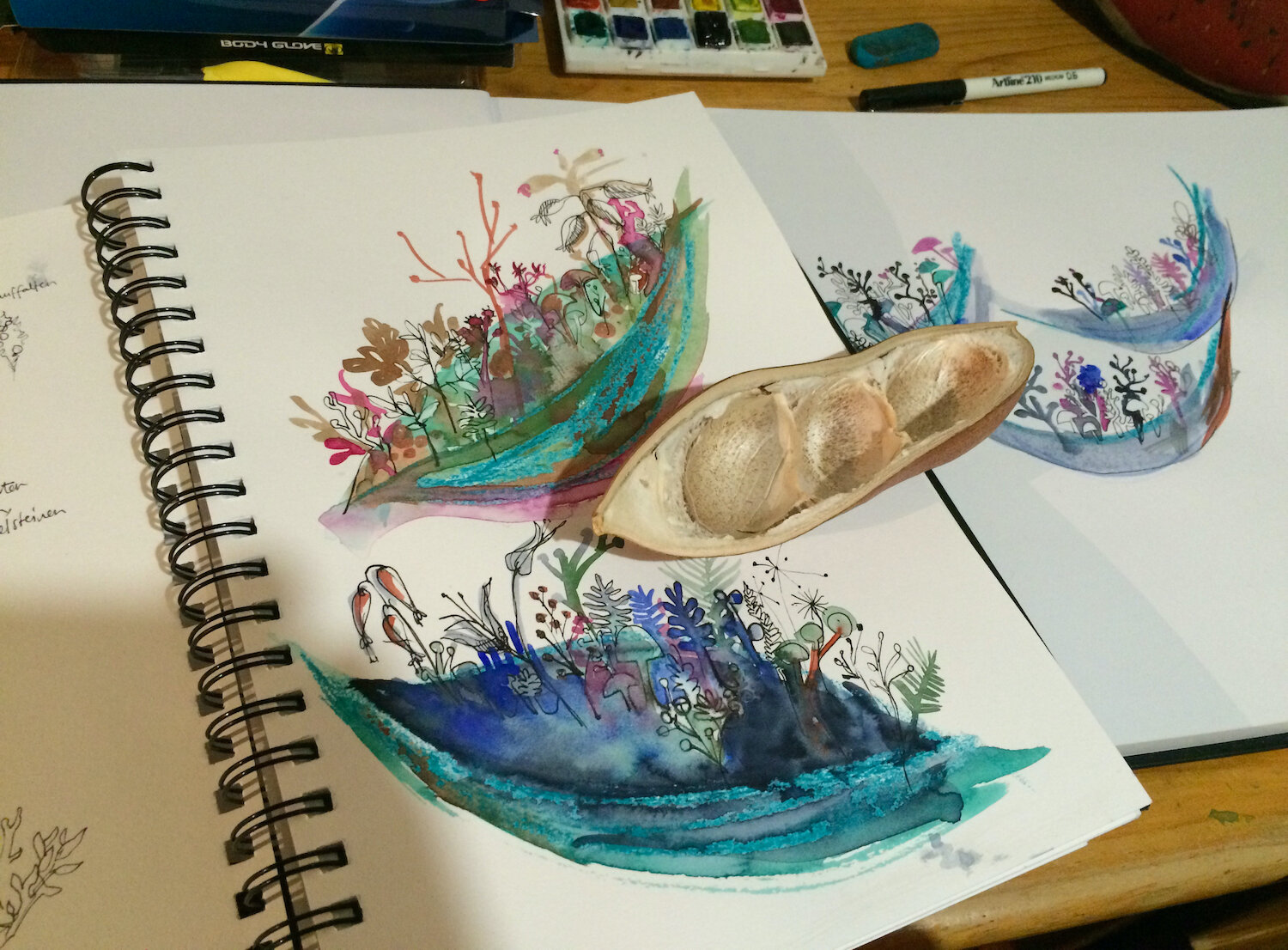
blog
Welcome to my blog. This is a place where I think out loud, show you what I’m up to in the studio, share impressions of inspiring events or everyday moments that moved me. Some entries are carefully curated essays, others are just a few thoughts, sometimes written in English and sometimes in German.
Featured posts

newest blog entries:
An interview: Diving into infinite imaginary worlds
Recently, Klimt02, an online platform and network for contemporary jewellery, published an interview with me about my work process and sources of inspiration. It was a wonderful opportunity to rethink the way I work and re-articulate my “why” and “how” to myself in these turbulent times.
Recently, Klimt02, an online platform and network for contemporary jewellery, published an interview with me about my work process and sources of inspiration. It was a wonderful opportunity to rethink the way I work and re-articulate my “why” and “how” to myself in these turbulent times.
I thought I’d share part of the interview with you here:
1. What's local and universal in your artistic work?
Since I was raised in South Africa by a German-South African mother and a Hungarian father, I don’t just have a single identity. I have always been very aware of the fragmented, fluid way identities are built, and how important the role of one’s environment is. I can trace this thought in the way I work: there are fragments of my inspiration pointing back to so many different sources, splinters and glimpses of all the places I spent time in. I think the fact that there is this interwoven tapestry of references and inspiration in my work makes it somehow local and universal at the same time, if such a thing is possible.
There are echoes of European fairy tales and Germanic legends, but also African colours and that very South African skill of improvising in the moment; the flavour of Hungarian paprika; details of the Cape Fynbos flora; a purple Table Mountain and the aching beauty of the Wild Coast; classical double bass music; barefoot childhood memories in the vineyards; almond blossoms; hateful school uniforms; a great search for freedom and adventure. In all the visual chaos there is a search for an inner dream world, a garden that is both the origin and end, an internal fountain of inspiration, and a place to move towards.
Imaginary botanical painting with watercolour, pen and drawing ink. Drawings like these are searches for new shapes and design drawings simultaneously.
2. Are there any other areas besides jewellery present in your work?
My work is completely interdisciplinary. I paint, mostly in watercolour but also in mixed media, I work in collages, I write, I make jewellery and enamelled metal objects, or strange sculptural compositions from found materials. In all these aspects of my work, I try to speak the same langue, creating a recognizable flavour of an inner Studio Nora Kovats world.
3. When you start making a new piece what is your process? How much of it is a pre-formulated plan and how much do you let the material spontaneity lead you?
My drawings are entirely spontaneous, as if I’m tapping into a wild imaginary garden inside myself, bringing out treasures to shape into compositions. This is where I first developed my visual language.
When making contemporary jewellery and metal objects, I generally have a more specific idea about the direction I am headed in. There’s a creative moment of composition where the elements are brought together, but the making of individual parts is often a very time consuming and laborious process that requires a lot of patience.
I never make just one piece at a time; it’s a creative process in several disciplines simultaneously, and I usually work on up to twenty pieces at the same time.
I mix precious and non-precious materials (such as copper, plastic, nylon and enamel in combination with gold and gemstones) and use symbolically laden resources and forms, yet aim to create something that has become precious above all because of its uniqueness – a distinctiveness born from my personal intrinsic visual language and the meticulousness of my labour. I definitely do believe that a creation of mine should strike the viewer as a precious object; however, this should be due to the skill and time invested. Because real value in this fleeting world of ours does not lie in gold or gemstones, but in human time, in devotion, passion and sincerity.
Jewellery-making offers the possibility to create entire worlds – contained miniature environments, secret spaces, autonomous ecosystems functioning in complex webs of meanings. When creating a piece, the artist pores over the small artwork in such a way that the centre of his or her world temporarily shrinks to a physical space measured in centimetres, but the metaphorical and imaginative space may be vast: a whole world of symbolism and emotion. Like with the containment of a garden in comparison to the vastness of the universe, the world in a jewellery object shrinks to a microcosm. Preciousness, usually ascribed to a range of metals and gemstones, is to some extent a quality of smallness too. A small object can be cradled in the hand; it can be more easily lost than a larger item and thus requires safe-keeping.
The size of my work is determined by several considerations: it does not consist of massive installations because of certain practical limitations, such as the size of the enamelling kiln and the extreme labour-intensity of the work; however, I also aim to evoke a sense of a miniature contained world that activates the viewer’s imagination and begs for intimate visual exploration. Smallness, of course, creates a sense of intimacy; the work displays marks of my hands on it – filing marks and hammer dents, fingerprints, perhaps even bits of my DNA and most certainly a small portion of my soul. This idea might seem overly romantic, but it embodies my personal approach to my work, conceived through the process of making.
Adding a gemstone cluster of iolite and garnet to these silver and enamel earrings to complete the composition as I imagined it in my mind.
Late-night watercolour and ink sketching inspired by a seed pod I found on one of my extended walks.
4. How important is the handmade for you in your development? What role do techniques and
technology play in your development?
Although I recognize the importance of new technological developments in general, I am a strong supporter of hand-crafted as opposed to machine-made work. I believe that we enshrine some part of ourselves within an object if we spend hours laboring over it.
My hope is that we will be moving into a time – perhaps accelerated now due to the Covid-19-crisis – where we can move away from the useless consumption of meaningless, cheaply made, trendy objects and towards a sensibility where quality, aesthetics, true craft skills and manual labour are highly valued again. Perhaps we can rise from the ashes of this upcoming severe recession as phoenixes who can forge emotional value in the form of artistic expression and express humanity in a way that creates meaning for people.
My favourite jewellery techniques include sawing out of metal, soldering to construct shapes, and enameling. My thoughts keep returning to the process of enamelling and the complete devotion it demands of its practitioner. This creative process, with its vivid possibilities of colour, its laborious ritualistic method and its ties to alchemical practices, inspires a creative drive in me that compels me to make. The making, in its quality of searching, almost becomes more important than the finished work. Making becomes a rhythmic ritual, demanding respect and reverie, as well as the need to be patiently observed, step by step, without rush. To me, the enamels are governed by their own rules, almost taking on a life of their own.
As I make, I am concerned with growing something from nothing, and with controlling that created something to a certain extent. A contradiction exists between the tight control imposed on the contained microcosm of my work, or on the enamel kiln as closed environment, and the spontaneity, impulsiveness and freedom required to permit a truly successful result – one that lives. This duality intrigues me – a constant balance between tight control and letting go. A dance. It has allowed a particular style to emerge in my work: with an emphasis placed on intuition and playfulness, I focus on growing, twisting, branching botanical shapes and vivid, unexpected colour combinations, dark and twisted as well as vibrant and playful.
Sawing stylized pomegranate shapes from a textured sheet of silver with my beloved jeweller’s saw. Here, the saw becomes an extension of my hand: a drawing tool to trace lines.
5. How important is wearability in contemporary jewellery? And in your pieces?
I think that my work changed quite a bit with regards to wearability. I used to make these crazy, spiky jewellery objects that really didn’t focus on wearability too much. They were fascinating, but rather uncomfortable to wear. As I started to earn money with my designs, my work had to be split into two distinct directions by necessity: I developed simpler, more wearable jewellery pieces such as earrings and pendants that echoed the turmoil of more intricate, entirely unwearable objects, meant to function as art in their own right.
Enamelling still life showing some of my tools like tweezers and a sieve, enamel powders and a stylized pomegranate that I am working on.
6. Which piece or job gave you more satisfaction?
There are two types of satisfaction I get in my work. Depending on my mood, I seek out either of them.
The first is a crazy, creative state of flow where I try new things, create compositions or quick sketches. This type of work flow needs a lot of momentum and energy, and although it is highly enjoyable, I cannot sustain it for too long. It’s a fast-burning, fire-like inspiration that exhausts itself after a couple of hours. This is where I create new ideas, put together final pieces, enamel pieces in quick succession or paint and draw in fast, fluid strokes.
The other is a slower, more purposeful state of meditative work, which I enjoy when I am in a more peaceful state of mind. This is where I spend hours hand-sawing intricate patterns and then finishing them off with my Swiss needle files, burnishing edges or polishing little details. Most people experience these kinds of laborious activities as frustrating or wasted time, but to me, they are essential to balance out my creative practice. It’s a space where my mind wanders, where I can listen to podcasts and audiobooks, and vaguely dream about new ideas.
7. What do you expect when you show your work to the public (for example, with an exhibition)?
I hope to open a little window into my own creative thinking, I hope to touch people emotionally and activate their imagination to develop the piece further and invent their own paradises. I love when people really take the time to look at my pieces, which are often very intricate - as if they were turning into miniature versions of themselves and going for a walk inside the sculptural shapes.
My realistic expectations at any exhibition are that many people will not understand my work or want to engage with it, but that a few viewers will stop and be drawn in by it, truly fascinated and inspired. You can’t make everybody happy, and I really don’t want to appeal everyone at once.
_
To read the interview on Klimt02, have a look here.
Work bench still life with tools and half-finished pieces. I usually work on several pieces at the same time.












It’s winter. I cherish this white and noiseless time between the bustle of our Christmas season and the start of the new year. Since moving to Europe, it’s taken me a few years to learn to fully appreciate winter. Now, I know it’s one of the reasons I wanted to move here in the first place: I needed a real winter, I needed its pause and reflection, its going-underground, its gathering-of-forces, its quiet stripping away of the unnecessairy, its gestation for new creativity to emerge.